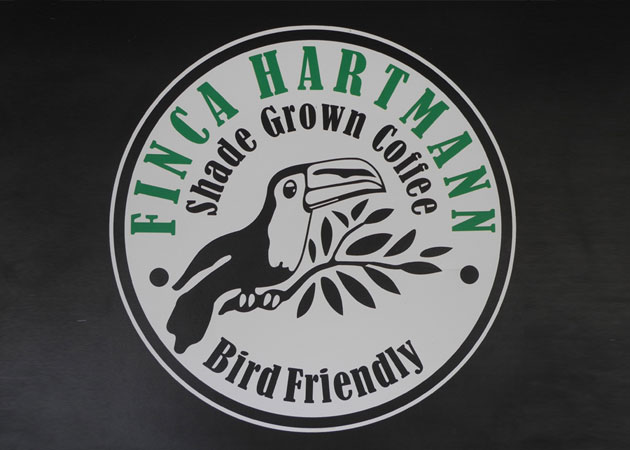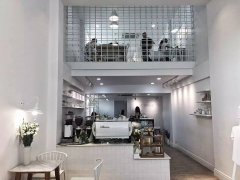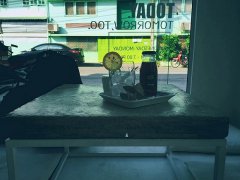Hartman Manor single Bean Flavor description Variety planting Development History production area treatment method

For professional baristas, please follow the coffee workshop (Wechat official account cafe_style)
Panama Hartmann Estate of Hartmann Manor in Panama
When it comes to Panamanian coffee tradition, most of the boutique coffee producing areas that are familiar to the public come from Boquete, but in recent years, coffee from Volcan has gradually emerged in the boutique market, and at the same time, a considerable number of estates have entered the best Panama competition (Best of Panama) or even won the championship. Generally speaking, the average annual rainfall in Walken is less than that in Borquette. At the same time, the geographical environment located to the west of the Baru volcano also gives coffee a stronger dried fruit flavor, sweetness and aroma than the Boguet region. In the early days, most of the cash crops such as fruits and vegetables were grown in Walken, and only a few farmers grew coffee, among which the pioneer of coffee cultivation in Walken belonged to the Hartman family, which was well-known in Panama.
The story of the Hartmann family in Panama can be said to be a long history of European immigration. Alois Strasil Hartmann was born in the Austro-Hungarian Empire at that time, that is, the present-day Czech Republic. Later, due to the unstable national politics, Alois decided to start a new life outside the country. At first, Alois stayed in New York and then moved to Panama, but after a few months, Alois found that he was not adapted to the urban life of Panama City. DNA, who had always had adventures in his blood, decided to work and settle down along the mountain line to the Walken area shortly after quitting his job. He also married his first wife Susana Troetsch and gave birth to Hartmann Troetsch, the founder of Hartman Manor. Hartmann Troetsch inherited his father's farmland and began land preparation work in 1940, and then started the history of Hartman Manor to this day. During the initial reclamation, the old Hartman decided to retain most of the original woodland in the manor, and this concept of primary forest protection has always influenced the third generation of manor owners who are now in charge of management. Hartman Manor still maintains this tradition. The coffee planting land in the manor accounts for only about 20% of the whole manor. due to the results of woodland conservation, there are quite a lot of native birds in the manor. And the most famous big-billed bird in the area has naturally become the standard Logo of the manor.
At present, the five children of Hartmann Troetsch handle the large and small affairs of Hartman Manor, among which the eldest Ratibor and Kelly are mainly responsible for the planting, breeding and fertilization of coffee in the park, which is the soul of Hartman Manor. In addition to its own estate, the Hartmann family also provides management services for estates near Volcan. For example, Ninety Plus's estate in Panama has maintained a close relationship with the Hartmann family to manage various matters within the estate.
The Eye of Water has always been a favorite area in Hartman Manor, which is located at a high altitude in the manor and its annual output is very rare. at present, only a few varieties of geisha, Kaddura and Kadui are planted in this area. the manor has a total area of 120 hectares, of which only 20 hectares are used as planting land. Another estate, named Santa Clara, is the site of Hartman's washing plant in addition to serving as a coffee farm and nursery plant. it is also an area where landowners experiment with the flavor of different varieties, with a total of more than ten varieties currently being tested and more if potential varieties are planned for future planting.
Hartman Manor washing Hartmann Estate Washed
■ country: Panama
■ producing area: Walken
■ altitude: 1250-1800 m
■ treatment: washing
■ level: SHB
■ variety: Arabica
■ flavor description: drupe, cream, vanilla and herb tail rhyme
Hartman Manor Solar Hartmann Estate Natural
■ country: Panama
■ producing area: Walken
■ altitude: 1250-1800 m
■ treatment: insolation
■ level: SHB
■ variety: Arabica
■ flavor description: wine aroma, fruit juice, grape, longan
Hartman Pacamara Sun Hartmann Estate Pacamara Natural Hartman Manor Pacamara Sun
■ country: Panama
■ producing area: Walken
■ altitude: 1250-1800 m
■ treatment: insolation
■ level: SHB
■ variety: Pacamara
■ flavor description: dried fruit, smoking, cardamom spices, onion, melon and fruit aromas
Hartman geisha sun Hartmann Estate Geisha Natural Hartman Manor geisha sun
■ country: Panama
■ producing area: Walken
■ altitude: 1250-1800 m
■ treatment: insolation
■ level: SHB
■ breed: geisha
■ flavor description: citrus, melon and fruit aromas, tropical fruits
The annual international cup test competition held in recent years and the emergence of the competition for "Best Coffee in Panama" Best of Panama and Panamanian Emerald Manor (Hacienda La Esmeralda) have completely changed, which has attracted global attention, in addition to the attraction of coffee itself, of course, there is also an amazing sky-high price. Geisha geisha from some small farms attract coffee fans all over the world with their unique flower scent.
The small farms in the Boquete Pokai butterfly producing area do produce distinctive coffee cherries. During the harvest season, the farm employs the local natives of Nobebugre Indians, and is employed at the most reasonable salary in accordance with the labor laws of Central America.
Sun-dried beans have always been the strength of Panamanian coffee, stable technology and systematic analysis ability to create extraordinary beans, Hartman Manor is a coffee estate run by the Hartmann family, founded by Alois Strasil Hartmann, many areas of the estate are virgin forests, and it is also one of the buffer zones across Costa Rica and Panama's famous La Amistad forest reserve. The coffee grown here grows under the shade trees of the rainforest.
Property Characteristics: farm characteristics
Name of Farm Farm:
Region producing area: Boquete Pokai butterfly
Location location: the eastern slopes of the Eastern slopes of Volcan Baru Baru volcano
Country countries: Panama Panama
Altitude altitude: 2100 m
Annual Precipitation annual rainfall: 4500 mm
Soil soil: Volcanic clay volcanic soil
Workers' mode of operation: local Nobe Bugre aborigines harvest by hand
Certification certification: Organic cert. By Bio Latina Central and South American Agriculture and Animal Husbandry Organic Organization Certification Rainforest Alliance
Coffee Characteristics: coffee characteristics
Variety variety: Caturra Kaddura
Processing System treatment: sun exposure
Flowering period flowering period: September-October September to October
Harvest period harvest time: March-July March to July
Appearance appearance:. 16-18 mesh
Top Jury Descriptions judge's comment: the baking degree measured by the cup for 60 seconds at the beginning of the first explosion (Cinnamon)
Aroma aroma / flavor flavor: delicate aroma of cranberry, mango fermentation, variety of berries, cherries
Acidity: grapefruit sour, cherry, orange, acid value is not fine and coarse
Complex complexity and other other: mango cantaloupe fermented fruit sweet, balanced oil ester high taste, low complexity, Yu Yun black tea aroma
Cup test score and overall review of direct coffee
Cup test date: 2015.05.31
Cup test score: 88
Hartman Manor named the coffee farm after the family name, the family coffee is shade coffee Shade Grown Coffee, has been the leader of Panamanian boutique coffee for many years. From the very beginning of the establishment of the coffee garden, the founder adhered to the friendly environment and the protection of forest ecology, and devoted himself to protecting the dense primeval forest with the principle of non-deforestation. Grow coffee in such a shady environment, so that coffee can grow slowly, the fruit has enough time to conceive, so that coffee cherries have good sweetness and beautiful sour taste, excellent flavor, become synonymous with shade coffee Shade Grown Coffee.
Because of its good natural ecology, Hartman Manor has a wide variety of creatures, including a variety of exotic birds, and they have also obtained bird-friendly certification, allowing this honor to be displayed on the estate's Logo, becoming a pioneer in the environmentally friendly coffee cultivation of Panama. Due to the efforts of the Hartman Manor family in environmental conservation, it has also been recognized by the scientific community, making the coffee farm a very popular eco-tourism area.
Hartman Manor
Growing area: Latin America
Country: Panama
Production area: Boquete
Altitude: 1200 Murray 2000 meters
Treatment: honey treatment
Varieties: Caturra, Catuai
Appearance: SHB strictly selects extremely hard beans.
Certification: bird-friendly, shady cultivation
Quenching: hand-brewed coffee, French filter kettle, siphon pot
Panamanian Hartmann hand-made coffee:
When making by hand, grind the coffee beans into coarse grinding (such as coarse granulated sugar particles); the temperature, in our experience, is close to 90 ℃, not more than 90 ℃, to show the characteristics of this coffee. You can change the way you brew and create your favorite flavor, which is the interesting charm of handmade coffee--
When it comes to Panamanian coffee tradition, most of the boutique coffee producing areas that are familiar to the public come from Borquette, but in recent years, coffee from Volcan has gradually emerged in the boutique market, while a considerable number of estates have entered the best Panamanian competition (Best of Panama) and even won the championship. Generally speaking, the average annual rainfall in Walken is less than that in Borquette. At the same time, the geographical environment located to the west of the Baru volcano also gives coffee a stronger dried fruit flavor, sweetness and aroma than the Boguet region. In the early days, most of the cash crops such as fruits and vegetables were grown in Walken, and only a few farmers grew coffee, among which the pioneer of coffee cultivation in Walken belonged to the Hartman family, which was well-known in Panama.
The story of the Hartmann family in Panama can be said to be a long history of European immigration. Alois Strasil Hartmann was born in the Austro-Hungarian Empire at that time, that is, the present-day Czech Republic. Later, due to the unstable national politics, Alois decided to start a new life outside the country. At first, Alois stayed in New York and then moved to Panama, but after a few months, Alois found that he was not adapted to the urban life of Panama City. DNA, who had always had adventures in his blood, decided to work and settle down along the mountain line to the Walken area shortly after quitting his job. He also married his first wife Susana Troetsch and gave birth to Hartmann Troetsch, the founder of Hartman Manor. Hartmann Troetsch inherited his father's farmland and began land preparation work in 1940, and then started the history of Hartman Manor to this day. During the initial reclamation, the old Hartman decided to retain most of the original woodland in the manor, and this concept of primary forest protection has always influenced the third generation of manor owners who are now in charge of management. Hartman Manor still maintains this tradition. The coffee planting land in the manor accounts for only about 20% of the whole manor. due to the results of woodland conservation, there are quite a lot of native birds in the manor. And the most famous big-billed bird in the area has naturally become the standard Logo of the manor.
In botany, coffee tree belongs to the evergreen tree of subgenus Rubiaceae. Coffee bean is the seed of coffee tree fruit, among which there are three major varieties: Arabica, Robusta and Liberica. Different subspecies can not be mixed among these three varieties. All the fine coffee in the world comes from Arabica species, and there are various subspecies of Arabica coffee, such as evolution, hybridization, mutation and so on.
Kaddura species (Caturra)
The Bourbon mutant was first found in Brazil. The palate is sour with lemon or citrus flavors and fruity in sweetness. although the sweetness is not as sweet as Typica and bourbon, the sweetness can be very good with proper baking. Kaddura's sweetness is determined by the number and dose of fertilizer applied by the grower, and the harvest period takes 2 years and the care cost is high, so the yield is still limited.
When we came to Hartman Manor in Panama, we saw that people growing coffee here always followed the requirements of green protection, and the farm compost was made from pulp and cherry skins. Curious about what kind of coffee taste will be nurtured in such an environment, I can't wait to make a cup of Hartman. Ta has a pure flavor, sweet and bright tone, strong honey flavor and stone fruit sweet flavor. Every inch of the mouth has a mellow taste of milk chocolate, even if it is cold. In addition to the local superior climatic conditions, careful cultivation and strict picking, its perfect taste also comes from the special treatment-red wine treatment.
Red wine treatment of coffee beans:
It can also be called red wine treatment, which is inspired by the brewing technology of red wine. At present, only eight estates in Colombia have successfully introduced coffee beans treated with this method to the market. According to the data of these eight estates, we can roughly divide the types of red wine treatment into: acetic acid fermentation (Aerobic aerobic fermentation), lactic acid fermentation (Anaerobuic anaerobic fermentation), mixed fermentation (Mix Fermentation=Aerobic+Anaerobuic).
The traditional treatment method is difficult to control the changeable fermentation degree of coffee beans. But red wine treatment rules can ensure the quality of coffee beans by controlling PH value, even temperature and humidity, and airtight fermentation makes aroma less volatile.
Next, let's talk about the specific process of fermentation. First of all, Colombian farmers carefully pick coffee cherries and carefully select coffee red fruits to ensure that among the coffee cherries selected for processing, the percentage of immature cherries is less than 2%, defective beans less than 3%, and floating beans less than 5%.
The selected coffee cherries are placed in a specific container by the farmer's uncle, which should have a device similar to a red wine fermentation suppository or a single exhaust valve. In this way, carbon dioxide can be spilled through the device to control the concentration of air in the container. At this time, the coffee cherries in the container are fermented with acetic acid, and the beans are relatively bright, clean and citric acid.
Important Notice :
前街咖啡 FrontStreet Coffee has moved to new addredd:
FrontStreet Coffee Address: 315,Donghua East Road,GuangZhou
Tel:020 38364473
- Prev

What are the characteristics of Kilimanjaro coffee beans? description of the flavor of coffee bean varieties
For professional baristas, please follow the coffee workshop (Wechat official account cafe_style). The coffee produced in Ruvuma in southwestern Tanzania has wine and fruit aromas, which is different from that in the north near Mount Kilimanjaro. Mount Kilimanjaro is located in northeastern Tanzania. It is the largest coffee producing area in Tanzania, accounting for 75%.
- Next

Kilimanjaro Coffee Bean producing area Flavor description Manor treatment History
Professional baristas exchange please follow the coffee workshop (Wechat official account cafe_style) Kilimanjaro Coffee-characteristic Kilimanjaro coffee is a uniform size of large coffee beans, the color is grayish green, compared with a strong sour and sweet flavor, excellent flavor. Moderate baking will give off sweetness and light sour taste, deep baking will produce soft bitterness, suitable for
Related
- Detailed explanation of Jadeite planting Land in Panamanian Jadeite Manor introduction to the grading system of Jadeite competitive bidding, Red bid, Green bid and Rose Summer
- Story of Coffee planting in Brenka region of Costa Rica Stonehenge Manor anaerobic heavy honey treatment of flavor mouth
- What's on the barrel of Blue Mountain Coffee beans?
- Can American coffee also pull flowers? How to use hot American style to pull out a good-looking pattern?
- Can you make a cold extract with coffee beans? What is the right proportion for cold-extracted coffee formula?
- Indonesian PWN Gold Mandrine Coffee Origin Features Flavor How to Chong? Mandolin coffee is American.
- A brief introduction to the flavor characteristics of Brazilian yellow bourbon coffee beans
- What is the effect of different water quality on the flavor of cold-extracted coffee? What kind of water is best for brewing coffee?
- Why do you think of Rose Summer whenever you mention Panamanian coffee?
- Introduction to the characteristics of authentic blue mountain coffee bean producing areas? What is the CIB Coffee Authority in Jamaica?

